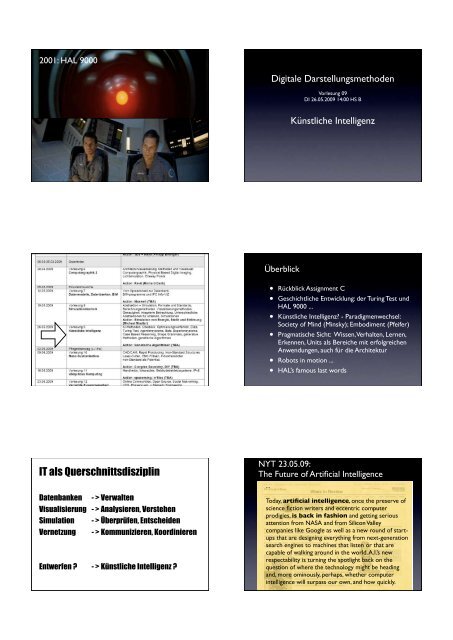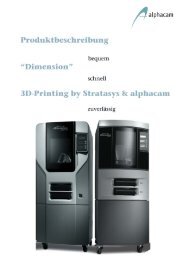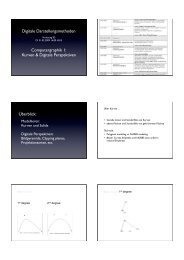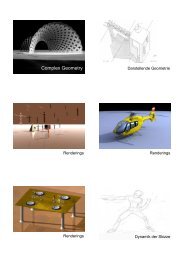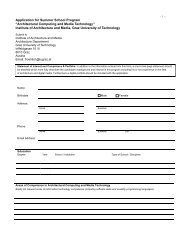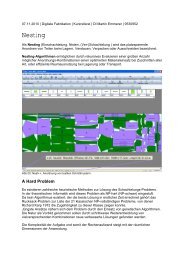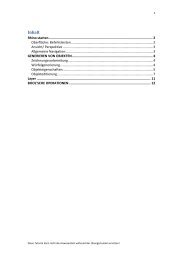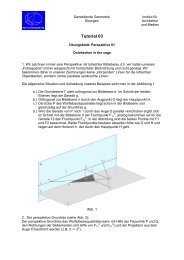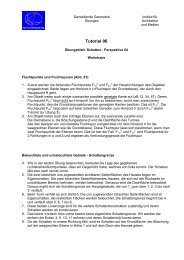V9_slides - Institut für Architektur und Medien
V9_slides - Institut für Architektur und Medien
V9_slides - Institut für Architektur und Medien
Create successful ePaper yourself
Turn your PDF publications into a flip-book with our unique Google optimized e-Paper software.
2001: HAL 9000<br />
IT als Querschnittsdisziplin<br />
Datenbanken - > Verwalten<br />
Visualisierung - > Analysieren, Verstehen<br />
Simulation - > Überprüfen, Entscheiden<br />
Vernetzung - > Kommunizieren, Koordinieren<br />
Entwerfen ? - > Künstliche Intelligenz ?<br />
Digitale Darstellungsmethoden<br />
Überblick<br />
Vorlesung 09<br />
DI 26.05.2009 14:00 HS B<br />
Künstliche Intelligenz<br />
• Rückblick Assignment C<br />
• Geschichtliche Entwicklung: der Turing Test <strong>und</strong><br />
HAL 9000 ...<br />
• Künstliche Intelligenz? - Paradigmenwechsel:<br />
Society of Mind (Minsky); Embodiment (Pfeifer)<br />
• Pragmatische Sicht: Wissen, Verhalten, Lernen,<br />
Erkennen, Units als Bereiche mit erfolgreichen<br />
Anwendungen, auch <strong>für</strong> die <strong>Architektur</strong><br />
• Robots in motion ...<br />
• HAL’s famous last words<br />
NYT 23.05.09:<br />
The Future of Artificial Intelligence<br />
...<br />
Today, artificial intelligence, once the preserve of<br />
science fiction writers and eccentric computer<br />
prodigies, is back in fashion and getting serious<br />
attention from NASA and from Silicon Valley<br />
companies like Google as well as a new ro<strong>und</strong> of startups<br />
that are designing everything from next-generation<br />
search engines to machines that listen or that are<br />
capable of walking aro<strong>und</strong> in the world. A.I.’s new<br />
respectability is turning the spotlight back on the<br />
question of where the technology might be heading<br />
and, more ominously, perhaps, whether computer<br />
intelligence will surpass our own, and how quickly.
Friend or Foe? In “Terminator Salvation,” computers surpass<br />
and plan to eliminate humans. (NYT 23.05.09)<br />
Duden <strong>für</strong> Informatik<br />
Grabwespe “Sphex ichneumoneus”: scheinbar intelligentes Verhalten<br />
! Die an Schwungkraft deutlich einbüßende Debatte über Künstliche<br />
Intelligenz erinnert uns daran, dass über Jahrzehnte hinweg die Leitbilder,<br />
welche die Entwicklung des Computers begleiteten <strong>und</strong> kommentierten,<br />
den Bahnen eines anthropomorphen Technikbildes folgten, dessen Pointe<br />
darin bestand, technische Instrumente im Horizont einer prothesenhaften<br />
Verstärkung <strong>und</strong> Ersetzung menschlicher Sinnes-, Bewegungs- <strong>und</strong><br />
Denkorgane zu deuten. In dieser Perspektive galt - <strong>und</strong> gilt noch immer -<br />
der Computer als ein Werkzeug der Kopfarbeit, als eine<br />
Geistestechnologie. Doch dieses an der Steigerung menschlicher<br />
Tätigkeitsvollzüge orientierte Verständnis des Technischen birgt eine<br />
Dialektik, die allzu leicht eine nüchterne Werkzeugterminologie<br />
umschlagen lässt in eine emphatische Ersetzungs- oder<br />
Entmächtigungsrhetorik.<br />
Sibylle Krämer (aus dem Vorwort zu <strong>Medien</strong> Computer Realität)<br />
Künstliche Intelligenz?<br />
What is Intelligence?<br />
Quite simple human behaviour can be intelligent yet quite complex behaviour<br />
performed by insects is unintelligent. What is the difference? Consider the<br />
behaviour of the digger wasp, Sphex ichneumoneus. When the female wasp<br />
brings food to her burrow, she deposits it on the threshold, goes inside the<br />
burrow to check for intruders, and then if the coast is clear carries in the<br />
food. The unintelligent nature of the wasp's behaviour is revealed if the<br />
watching experimenter moves the food a few inches while the wasp is inside<br />
the burrow checking. On emerging, the wasp repeats the whole procedure:<br />
she carries the food to the threshold once again, goes in to look aro<strong>und</strong>, and<br />
emerges. She can be made to repeat this cycle of behaviour upwards of forty<br />
times in succession. Intelligence--conspicuously absent in the case of Sphex--is<br />
the ability to adapt one's behaviour to fit new circumstances.<br />
Mainstream thinking in psychology regards human intelligence not as a single<br />
ability or cognitive process but rather as an array of separate components.<br />
Research in AI has focussed chiefly on the following components of<br />
intelligence: learning, reasoning, problem-solving, perception,<br />
and language-<strong>und</strong>erstanding.<br />
Quelle: alanturing.net
Alan Turing: “Turing Test”<br />
! Computing Machinery<br />
and Intelligence (1950)<br />
! Turing Test : „If a<br />
machine can't be told<br />
apart from a human in<br />
a conversation over a<br />
teletype, then that's<br />
good enough.“<br />
!<br />
In 1991 Dr. Hugh Loebner started the annual Loebner Prize<br />
competition. A $100,000 prize is offered to the author of the first<br />
computer program to pass an unrestricted Turing test.<br />
! http://cogsci.ucsd.edu/~asaygin/tt/ttest.html (turing test page)<br />
Eliza vs. Parry<br />
Quelle: alanturing.net<br />
Here is Turing's example of an exchange that might occur during the test.<br />
Interrogator In the first line of your sonnet which reads 'Shall I compare<br />
thee to a summer's day', would not 'a spring day' do as well or better?<br />
Computer It wouldn't scan.<br />
Interrogator How about 'a winter's day'? That would scan all right.<br />
Computer Yes, but nobody wants to be compared to a winter's day.<br />
Interrogator Would you say Mr. Pickwick reminded you of Christmas?<br />
Computer In a way.<br />
Interrogator Yet Christmas is a winter's day, and I do not think Mr Pickwick<br />
would mind the comparison<br />
Computer I don't think you're serious. By a winter's day one means a<br />
typical winter's day, rather than a special one like Christmas.<br />
Joseph Weizenbaum<br />
Eliza, ein virtueller Psychiater<br />
http://www-ai.ijs.si/eliza-cgi-bin/eliza_script<br />
http://bs.cyty.com/menschen/e-etzold/archiv/science/rat.htm<br />
Joseph Weizenbaum (* 8. Januar 1923 in Berlin; †<br />
5. März 2008 in Gröben bei Berlin) war ein<br />
deutsch-US-amerikanischer Informatiker sowie<br />
Wissenschafts- <strong>und</strong> Gesellschaftskritiker.<br />
Weizenbaum bezeichnete sich selbst als<br />
Dissidenten <strong>und</strong> Ketzer der Informatik.<br />
Why The Turing Test is AI's<br />
Biggest Blind Alley<br />
Blay Whitby 1997<br />
! http://www-ai.ijs.si/eliza-cgi-bin/eliza_script ! „The main consequence of perceiving intelligence in<br />
terms of some sort of imitation of human<br />
performance, such as success in the imitation game,<br />
is that AI research and experiment has paid far too<br />
much attention to the development of machinery<br />
and programs that seek directly or indirectly to<br />
imitate human performance.“
Marvin Minsky<br />
Marvin Minsky<br />
! The Society of Mind (1985)<br />
Douglas Hofstadter:<br />
Hirn als Netzwerk<br />
von Assoziationen<br />
(Illustration aus Gödel,<br />
Escher, Bach)<br />
! “I'll call society of mind this scheme <strong>und</strong>er which each mind is<br />
made of many smaller processes. These, we'll call agents. Each<br />
mental agent by itself can do some simple thing that needs no<br />
mind or thought at all. Yet, when we join these agents in societies<br />
- in certain very special ways - this leads to true intelligence.”<br />
NZZ 4.12.02<br />
! “Der französische Philosoph René Descartes<br />
(1596-1650) glaubte noch, dass alle visuelle<br />
Information in der Zirbeldrüse zusammenlaufen <strong>und</strong><br />
in dieser 12 millimeter grossen Struktur auch<br />
motorische Handlungen geplant werden. Er<br />
betrachtete die kleine Drüse gewissermassen als<br />
Schaltzentrale des Gehirns. Doch obwohl<br />
Wissenschafter inzwischen mehr als 30 visuelle<br />
Areale identifiziert haben - eine Schaltzentrale im<br />
Sinne Descartes fand sich keine darunter.<br />
Mittlerweile hat man die Suche beendet: Die<br />
Neurowissenschafter sind sich heute einig, dass eine<br />
oberste Instanz im Hirn nicht existiert.”<br />
Bewusstsein / Consciousness<br />
“Ganz egal, wie gut sie bestimmte<br />
Aufgaben erledigen, Computer werden<br />
nie intelligent sein, weil sie kein<br />
Bewusstsein haben!”<br />
Marvin Minsky: Das ist auch gar nicht<br />
nötig. “You can build intelligence out of<br />
unintelligent parts.”<br />
! The Society of Mind (1985)<br />
Marvin Minsky<br />
! „The society theory of mind marks a new era. This profo<strong>und</strong> and<br />
fascinating book lays down the fo<strong>und</strong>ations for the solution of one of the<br />
biggest problems of modern science, that of the origin and evolution of<br />
thought and consciousness in natural and artificial intelligence.“ Prof. Guy<br />
Cellerier<br />
! The Society of Mind (1985)<br />
Marvin Minsky<br />
! „The society theory of mind marks a new era. This profo<strong>und</strong> and<br />
fascinating book lays down the fo<strong>und</strong>ations for the solution of one of the<br />
biggest problems of modern science, that of the origin and evolution of<br />
thought and consciousness in natural and artificial intelligence.“ Prof. Guy<br />
Cellerier
AI-Paradigmenwechsel<br />
Was ist Intelligenz?<br />
Classical and modern view of intelligence.<br />
Illustrations by Shun Iwasawa<br />
Quelle: AI-Lab UniZH<br />
–Erkennen<br />
–Wissen<br />
–Verhalten<br />
–Lernen<br />
–Einheiten (‚Units‘)<br />
Künstliche Intelligenz?<br />
KI = AI<br />
Artificial Intelligence<br />
Intuition<br />
Handeln! !<br />
! ! !<br />
Intelligenz<br />
Rationalität<br />
Denken
Erkennen<br />
• Computer Vision<br />
• Interpretieren von visuellem Input durch die Maschine<br />
• Speech Recognition<br />
• Spracherkennung, Beispiel "SBB Fahrplan" 157 2222.<br />
• Natural Language Processing<br />
• Das inhaltliche Verstehen von Sprache, das Generieren von<br />
inhaltlich sowie sprachlich korrektem Text <strong>und</strong> die<br />
Faehigkeit Konversationen zu fuehren.<br />
Herr Müller trägt die Krawatte, die seine Frau gekauft hat.<br />
! Dieser Satz enthält viel potenzielle Verwirrendes: Müller heißt<br />
so, es ist aber auch eine Berufsbezeichnung. Tragen: am Hals<br />
oder in der Hand? die, die: das zweite die bezieht sich auf die<br />
Krawatte. Seine bezieht sich auf Herrn Müller. Frau ist ein<br />
weiblicher Mensch, in diesem Fall vermutlich mit Herrn Müller<br />
verheiratet. Gekauft: Hat die Krawatte die Frau gekauft oder<br />
umgekehrt? Wir wissen, dass eine Krawatte nichts kaufen<br />
kann, dem Computer muss so etwas zuerst beigebracht<br />
werden.<br />
In general we are least aware of<br />
what our minds do best.<br />
Marvin Minsky
Wissen<br />
• ES - Experten Systeme<br />
• Regeln programmieren<br />
• Case-Based Reasoning = Fallbasiertes<br />
Schliessen<br />
• Fälle speichern <strong>und</strong> <strong>für</strong> die Problemlösung einsetzen<br />
Mitchell, Stiny:<br />
Shape Grammars<br />
Palladio Villen<br />
Vectorworks: Industry Specific Tools<br />
Walls<br />
Only geometrical attributes.<br />
Wall framing shows stud placement in a diagram,<br />
elevation drawings, 3D model and two different<br />
worksheets<br />
(Frame TakeOff and Frame Wall Info).<br />
Shape<br />
Grammars<br />
An expert is a man who has<br />
stopped thinking - he knows!<br />
- Frank Lloyd Wright<br />
Vectorworks: Industry Specific Tools<br />
Stairs<br />
Geometry defined and modified in detail in Object Info<br />
Roofs<br />
Dormer Windows<br />
Skylights<br />
Roof Face<br />
Floors<br />
Columns<br />
Defined in detail but not modifiable
Vectorworks: Plug-in Objects<br />
Geometrical Detailed<br />
Attributes can be modified.<br />
Stairs<br />
Doors<br />
Windows<br />
Openings<br />
Furnishing<br />
Makoto Sei Watanabe: Induction Design<br />
Verhalten<br />
• AL - Artificial Life<br />
• Systeme welche Leben simulieren mit dem Ziel das Leben<br />
verstehen zu lernen, indem f<strong>und</strong>amentale, dynamische<br />
Prinizipien mit dem Computer nachvollzogen werden. Den<br />
einzelnen Teilen werden Verhalten <strong>und</strong><br />
Interaktionsmöglichkeiten einprogrammiert. Das Ziel ist<br />
das Verstehen.<br />
• Beispiele: Tamagotchi, Creatures, SimCity, SimAnts.<br />
Conway: Game of Life<br />
• http://www.math.com/students/wonders/life/life.html<br />
• http://www.trevorrow.com/lifelab/
Regelbasierte Systeme<br />
Rule-Based Systems<br />
• Prozedurale Verfahren<br />
• Formengrammatiken (shape grammars)<br />
• Induction design (Makoto Sei Watanabe)<br />
Xfrog by Bernd Lintermann<br />
L-Systeme<br />
Aristid Lindenmayer (Ungar. Theor. Biologe <strong>und</strong> Botaniker, Univ. Utrecht)<br />
Xfrog<br />
Bild Copyright Wikimedia
Visualisierungsmethoden <strong>für</strong> die<br />
Simulation urbaner Szenarien<br />
Dr. Remo Burkhard<br />
Chair for Information Architecture<br />
www.horvath.ch
Donald Judd<br />
Lernen<br />
• NN - Neuronale Netzwerke<br />
• Simulation der Neuronen, wie sie in den Gehirnen von<br />
Tieren <strong>und</strong> Menschen vorkommen<br />
• GA - Genetische Algorithmen<br />
• Evolution von künstlichen Wesen. Die DNA wird simuliert<br />
<strong>und</strong> fuer die Fortpflanzung nur die Besten zugelassen. Zum<br />
Beispiel die Kreaturen von Carl Sims.<br />
! http://math.hws.edu/xJava/GA/
Karl Sims<br />
creatures, created with genetic algorithms<br />
GA: 2 Gr<strong>und</strong>bestandteile<br />
• Genetische Repräsentation<br />
(beliebig viele Parameter)<br />
• Fitness Funktion<br />
(Analyse / Evaluation)<br />
Genetische Algorithmen<br />
Suchtechnik:<br />
!Optimierungsprobleme<br />
Inspiriert von evolutionärer Biologie:<br />
!Vererbung<br />
!Mutation<br />
!Selektion<br />
!Crossover (recombination)<br />
Genetic algorithm<br />
! From Wikipedia, the free encyclopedia<br />
! A genetic algorithm (or short GA) is a search technique used in computing to find true or<br />
approximate solutions to optimization and search problems. Genetic algorithms are categorized<br />
as global search heuristics. Genetic algorithms are a particular class of evolutionary algorithms<br />
that use techniques inspired by evolutionary biology such as inheritance, mutation, selection, and<br />
crossover (also called recombination).<br />
! Genetic algorithms are implemented as a computer simulation in which a population of abstract<br />
representations (called chromosomes or the genotype or the genome) of candidate solutions<br />
(called individuals, creatures, or phenotypes) to an optimization problem evolves toward better<br />
solutions. Traditionally, solutions are represented in binary as strings of 0s and 1s, but other<br />
encodings are also possible. The evolution usually starts from a population of randomly generated<br />
individuals and happens in generations. In each generation, the fitness of every individual in the<br />
population is evaluated, multiple individuals are stochastically selected from the current<br />
population (based on their fitness), and modified (recombined and possibly mutated) to form a<br />
new population. The new population is then used in the next iteration of the algorithm.<br />
! Genetic algorithms find application in computer science, engineering, economics,chemistry,<br />
physics, mathematics and other fields.<br />
Herzog & de Meuron: Olympiastadion Beijing 2008<br />
Herzog de Meuron
75<br />
Daniel Libeskind: Futuropolis (HSG)<br />
Kaisersrot: Quartierplanung<br />
Ludger Hovestadt
Libeskind: Futuropolis HSG St. Gallen<br />
designtoconstruction caad ethz:<br />
Christoph Schindler, Fabian Scheurer, Markus Braach<br />
NDS CAAD<br />
Schutzhütte Monte Rosa
Units<br />
• Robots<br />
• Roboter = Physische Erscheinungen, welche mit KI<br />
Fähigkeiten ausgerüstet sind. oft eine Kombination<br />
verschiedener KI Aspekte Computer Vision, Speech<br />
Recognition, <strong>und</strong> weiterer Fähigkeiten, welche vielleicht<br />
mit genetischen Algorithmen entwickelt wurde.<br />
• Agents<br />
• Roboter ohne den physischen Teil. Im Moment sind vor<br />
allem Agents verbreitet, welche Informationen auf dem<br />
Internet suchen <strong>und</strong> filtern. Wichtig ist, dass zwischen<br />
Mensch <strong>und</strong> Agent ein Vertrauen aufgebaut werden kann.<br />
Rodney A. Brooks<br />
Director of the 800 person MIT Computer Science and<br />
Artificial Intelligence Laboratory,<br />
! Until the mid-1980's, AI researchers assumed that an intelligent system doing<br />
high-level reasoning was necessary for the coupling of perception and action. In<br />
this traditional model, cognition mediates between perception and plans of<br />
action. Realizing that this core AI, as it was known, was illusory, Rodney A. Brooks<br />
turned the field of AI on its head by introducing the behavior-based<br />
approach to robotics. The cornerstone of behavior-based robotics is the<br />
realization that the coupling of perception and action gives rise to all the power<br />
of intelligence and that cognition is only in the eye of an observer. Behavior-based<br />
robotics has been the basis of successful applications in entertainment, service<br />
industries, agriculture, mining, and the home. It has given rise to both<br />
autonomous mobile robots and more recent humanoid robots such as Brooks's<br />
Cog. This book represents Brooks's initial formulation of and contributions to the<br />
development of the behavior-based approach to robotics. It presents all of the<br />
key philosophical and technical ideas that put this "bottom-up" approach at<br />
the forefront of current research in not only AI but all of cognitive science.
Rodney A. Brooks<br />
Director of the 800 person MIT Computer Science and Artificial<br />
Intelligence Laboratory,<br />
Sony: Aibo<br />
(1999 - 2004)<br />
HONDA: Asimo<br />
(2005)<br />
96
Intuition<br />
Handeln! !<br />
! ! !<br />
AI-Paradigmenwechsel<br />
Classical and modern view of intelligence.<br />
Illustrations by Shun Iwasawa<br />
Quelle: AI-Lab UniZH<br />
Intelligenz<br />
Rationalität<br />
Denken<br />
101<br />
An expert is a man who has<br />
stopped thinking - he knows!<br />
- Frank Lloyd Wright<br />
Digitale Darstellungsmethoden<br />
Vorlesung 10<br />
DI 09.06.2009 14:00 HS B<br />
Mass Customization


